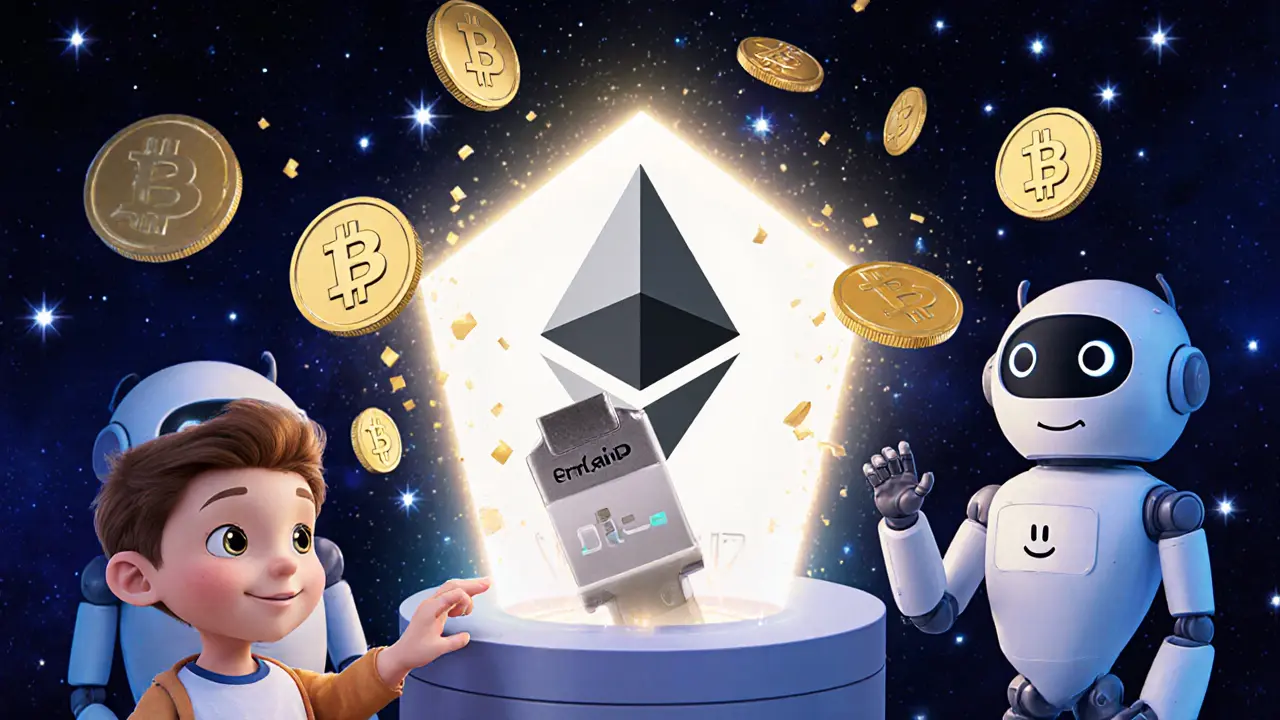MAID to eMAID Conversion Calculator
Conversion Results
0 eMAID tokens
Estimated Gas Fees: $2.50 (ETH)
Estimated Processing Time: 15-30 minutes
MaidSafeCoin (EMAID) isn't just another altcoin. It's a bridge to something bigger: a fully decentralized internet where you own your data, not corporations. Created in 2006 by Scottish engineer David Irvine, the project behind MaidSafeCoin - now called the SAFE Network - has spent nearly two decades building a system that replaces traditional servers with a peer-to-peer network of everyday users’ devices. Unlike Bitcoin or Ethereum, which rely on mining or staking, the SAFE Network runs on what’s called “farming”: users contribute spare hard drive space, bandwidth, and computing power to store and share data. In return, they earn tokens. MaidSafeCoin is the temporary token you get now, with the promise of a 1:1 swap to the real thing - SAFE tokens - once the mainnet launches.
How MaidSafeCoin Works: From Omni to Ethereum
When MaidSafeCoin first launched in 2014, it was built on the Omni Layer - a protocol that runs on top of the Bitcoin blockchain. Back then, you could buy MAID using Bitcoin, and it was stored in wallets like Electrum with Omni support. But Omni had limits. It was slow, expensive to use, and didn’t connect to the modern DeFi world. In 2021, the community stepped in and created eMAID - an ERC-20 version of MaidSafeCoin on the Ethereum blockchain. This was a game-changer.
Today, if you hold MAID, you can convert it to eMAID by sending your tokens to a burn address through a trusted custodian like Altcoinomy. Once burned, a smart contract on Ethereum mints an equal amount of eMAID and sends it to your wallet. The process takes 15 to 30 minutes and costs about $2.50 in gas fees. The result? You get a token that works with MetaMask, Ledger, Trezor, and decentralized exchanges like Uniswap. The original Omni-based MAID still exists, but almost all trading and usage now happens on eMAID.
As of mid-2025, the total supply of MaidSafeCoin across both versions is capped at 452,552,412 tokens. Of those, about 38.6 million are eMAID in circulation, with a market cap around $11.5 million. The price hovers around $0.058, down 94% from its all-time high of $1.20 in 2018. That drop isn’t because the idea failed - it’s because the network isn’t live yet.
The SAFE Network: More Than Just Storage
MaidSafeCoin only makes sense if you understand what it’s meant to unlock: the SAFE Network. This isn’t another blockchain for payments. It’s a complete overhaul of how the internet works. Instead of storing your photos on Google Drive or your files on Amazon’s servers, the SAFE Network breaks your data into encrypted pieces and scatters them across thousands of devices worldwide - including your neighbor’s unused hard drive.
When you upload a file, it’s automatically encrypted, split into chunks, and stored in a way that no single person - not even the network operators - can access your full data. You get back a unique address to retrieve it. No passwords. No login. No middlemen. And you earn SAFE tokens every time your device helps store or relay someone else’s data. That’s farming.
This model is fundamentally different from Filecoin, which only pays for storage. The SAFE Network also pays for bandwidth and computing power. It’s a full-stack decentralized internet: hosting, messaging, identity, and storage - all without servers. The vision? A world where your data can’t be hacked, censored, or sold without your permission.
Why It’s Still Not Live (And Why People Are Still Waiting)
Here’s the hard truth: after 16 years, the SAFE Network still hasn’t launched its mainnet. That’s why many call it vaporware. Critics point out that while the whitepaper from 2006 laid out a brilliant architecture, real-world execution has been painfully slow. The project has gone through four major development phases, with Version 4.0 released in March 2024 adding stronger encryption and better node coordination. But the final piece - the mainnet - is still pending.
In May 2024, the team announced a target launch date of Q4 2025. That’s the most concrete timeline they’ve ever given. If it happens, holders of MAID and eMAID will automatically receive SAFE tokens at a 1:1 ratio within 90 days. If it doesn’t? The tokens could become worthless.
Why the delay? Building a decentralized internet from scratch is harder than building a blockchain. It requires perfecting consensus algorithms, securing data routing, preventing Sybil attacks, and incentivizing honest participation - all without a central team controlling the network. It’s like trying to build a self-driving city where every car, traffic light, and road is owned by someone else. No wonder it’s taking time.

Who’s Still Holding? The Community Divide
The MaidSafe community is split. On one side, you have early adopters who bought MAID in 2014 for pennies. They’re still holding, believing the vision is worth the wait. One Reddit user wrote: “I’ve held since 2014. The internet is broken. This is the only fix.”
On the other side, there are people who lost money and patience. “Ten years of promises. No mainnet. No proof. Just whitepapers,” posted another user in July 2024. Trustpilot reviews for exchanges listing eMAID show a 3.2/5 average rating, mostly because of low liquidity and few places to trade it. Only 12 exchanges list eMAID, compared to hundreds for Bitcoin or Ethereum. You can’t buy it on Coinbase or Binance. You need to go to smaller platforms like Uniswap or MEXC.
But the community isn’t dead. The Autonomi Forum - the project’s main hub - still gets about 1,200 posts a month. Developers regularly post updates, code snippets, and testnet results. The documentation on GitHub is detailed and technical, praised for depth but criticized for being too hard for beginners.
Is MaidSafeCoin a Good Investment?
Let’s be clear: this isn’t a short-term play. If you’re looking to flip eMAID for a quick profit, you’re in the wrong place. The 24-hour trading volume is around $37,000 - less than a single tweet from a crypto influencer can move. The token’s value isn’t driven by speculation. It’s driven by one thing: the launch of the SAFE Network mainnet.
Experts are divided. Dr. Sarah Thompson, a blockchain researcher at Edinburgh University, says the farming model could solve Ethereum’s scalability issues by removing mining entirely. “It’s elegant,” she said in a 2023 interview. “But the economic model hasn’t been stress-tested in the real world.” Meanwhile, JPMorgan’s analysis team called it “high execution risk” in their Q2 2024 report.
On the flip side, Bernstein Research gave it a 65% chance of launching by 2026. If they’re right, early holders could see their tokens become worth thousands - not because the price went up, but because the network became useful. Imagine owning a token that gives you access to a global, censorship-resistant internet. That’s not speculation. That’s infrastructure.
The smart move? Only invest what you can afford to lose. If you believe in a decentralized internet, and you’re okay waiting two more years, eMAID might be worth holding. If you need liquidity or quick returns, walk away.

How to Buy and Store eMAID (Step-by-Step)
If you want to get involved, here’s how to do it safely:
- Get an Ethereum wallet - MetaMask is the easiest for beginners. Hardware wallets like Ledger Nano S or Trezor work too.
- Buy ETH on a centralized exchange like Kraken or Coinbase, then send it to your wallet.
- Go to Uniswap - connect your wallet and swap ETH for eMAID.
- Verify the contract address - always double-check you’re trading the right token:
0x329c6e459ffa7475718838145e5e85802db2a303. Scammers create fake tokens with similar names. - Store it securely - never leave large amounts on an exchange. Use your wallet.
If you already have old MAID tokens on Omni, you’ll need to convert them to eMAID via Altcoinomy’s portal. Follow their guide exactly. Mistakes here can mean permanent loss.
What Comes Next?
The next 12 months are critical. If the SAFE Network mainnet launches in Q4 2025 as promised, eMAID will become the most important crypto token you’ve never heard of. If it doesn’t? The project may fade into obscurity, like so many other ambitious blockchain dreams.
For now, MaidSafeCoin remains a bet on the future - not the present. It’s not a currency. It’s not a store of value. It’s a ticket to a new kind of internet. And whether that ticket is worth holding depends entirely on whether you believe humanity can build something better than the current web.
Is MaidSafeCoin (EMAID) the same as SAFE tokens?
No. MaidSafeCoin (EMAID) is a temporary proxy token used during the development of the SAFE Network. Once the mainnet launches, all MAID and eMAID tokens will be swapped 1:1 for the native SAFE tokens. SAFE tokens will be the actual currency used within the live network for paying for storage, bandwidth, and computing power.
Can I mine MaidSafeCoin?
No. MaidSafeCoin cannot be mined. Unlike Bitcoin or Ethereum (pre-merge), it doesn’t rely on mining. Instead, users earn tokens by “farming” - contributing unused hard drive space, bandwidth, and processing power to the SAFE Network. This process only becomes active once the mainnet launches. Until then, the only way to get EMAID is by buying it or converting old MAID tokens.
Where can I trade EMAID?
Ethereum-based EMAID can be traded on decentralized exchanges like Uniswap, SushiSwap, and MEXC. It is not listed on major centralized exchanges like Coinbase or Binance. Always verify the contract address: 0x329c6e459ffa7475718838145e5e85802db2a303. Avoid any token with a different address - they are scams.
What’s the difference between MAID and eMAID?
MAID is the original version built on the Omni Layer (Bitcoin blockchain). eMAID is the ERC-20 version on Ethereum. eMAID is far more useful today because it works with modern wallets and DEXs. The original MAID is nearly obsolete and can only be traded on a few niche platforms. Most users convert their MAID to eMAID to gain better access and liquidity.
Is MaidSafeCoin a security?
There’s a strong argument that it could be classified as a security by regulators like the U.S. SEC. The token was sold with the explicit promise of future utility (SAFE tokens) and was marketed as an investment in a developing network. The SEC’s 2023 guidance on proxy tokens suggests projects like MaidSafeCoin may need to register as securities - which could impact its legality in some countries.
What happens if the SAFE Network never launches?
If the mainnet never launches, eMAID and MAID tokens will likely lose all value. They serve no purpose outside the network. Without the ability to swap them for usable SAFE tokens, they become digital collectibles with no utility. That’s why experts warn: only invest what you can afford to lose. The project has a long history of delays - there’s no guarantee it will succeed.
